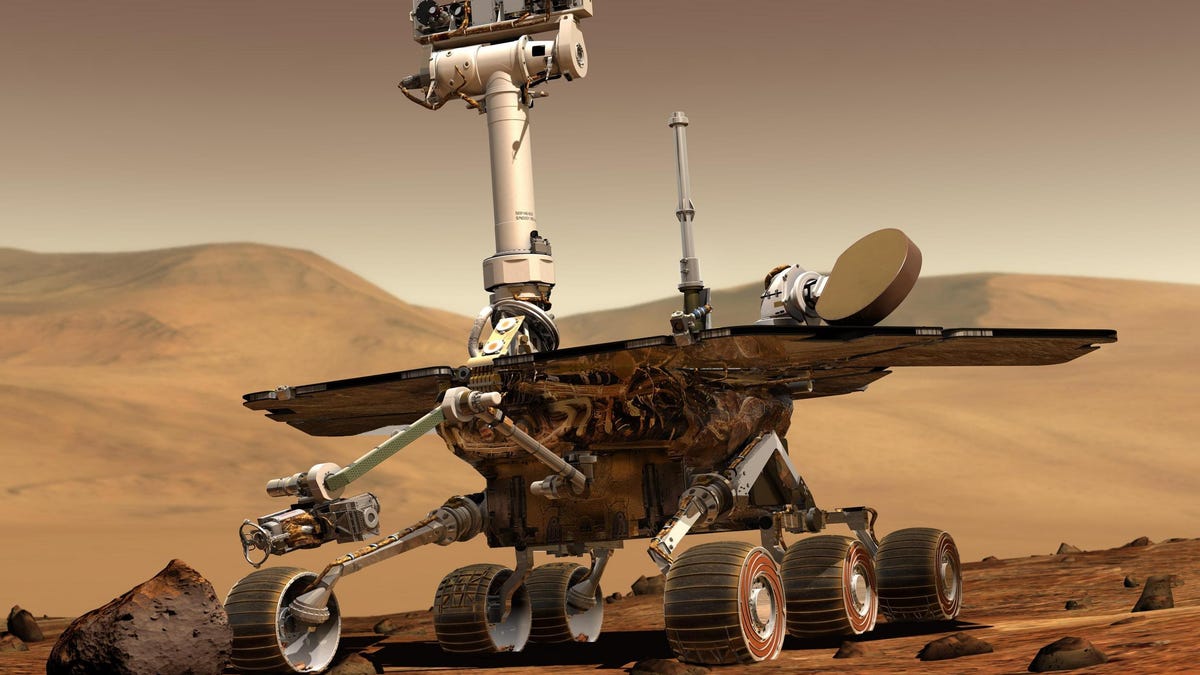NASA confirms Mars Opportunity rover didn't send signal back to Earth
One of NASA's radio antenna picked up a possible signal from Opportunity, but further investigation showed it was a false positive.

A NASA illustration shows what Opportunity would look like on Mars.
On Thursday afternoon, a signal received by DSS-54, one of NASA's Deep Space Network antennae, provided hope that Opportunity may be waking.
The Mars rover fell silent on June 10 in the midst of a planet-encircling dust storm that caked the rover's batteries in dust, preventing its solar panels from gathering extra juice. Since then, NASA has made numerous attempts to contact the rover, sometimes pinging the little robot daily to see if it would respond. It hasn't, but NASA has continued to hold out hope that Opportunity would phone home.
A bot account, @dns_status, which provides updates based on JPL's Deep Space Network, tweeted an update suggesting Opportunity may have awoken from its dust-induced slumber.
DSS 54 receiving data from Opportunity at 11b/s.
— Deep Space Network (@dsn_status) November 15, 2018
IN LOCK OFF 1 MCD2
Not a lot of information, but it seems that DSS-54 received data from Opportunity at around 1 p.m. PST. That data was transmitted at a speed of 11 bytes per second.
Some, including Chris Gebhardt, managing editor at NASA Spaceflight, suggested caution was warranted and that the signal may just be 'ghost data' from one of the spacecraft in orbit around Mars sending through data from an earlier point in time.
So to be clear. This could be from Oppy. It could also be a ghost -- a hold over or carrier from Mars Reconnaissance Orbit or Mars Odyssey. Hopefully, from Oppy. But caution. Putting all this out there, because it's a complicated search.
— Chris G - NSF (@ChrisG_NSF) November 15, 2018
Sadly, shortly after the detection, NASA's JPL sent an update out on Twitter, and our collective cosmic heart sank.
Today https://t.co/V3WGqQrrvJ showed what looked like a signal from @MarsRovers Opportunity. As much as we'd like to say this was an #OppyPhoneHome moment, further investigation shows these signals were not an Opportunity transmission.
— NASA JPL (@NASAJPL) November 15, 2018
NASA's investigation showed the signals were not from Opportunity and provided some clarity, explaining in a subsequent tweet that "test data or false positives can make it look like a given spacecraft is active" on the Deep Space Network website, when that may not be the case.
"As has happened previously, it could have been a Doppler shifted signal emanating from the Mars Reconnaissance Orbiter which has a frequency that is very close to Opportunity's signal," suggested Glen Nagle, NASA Operations Support Officer at the Canberra Deep Space Communication Complex.
DSS-54, which reported the false--positive, is a parabolic antenna -- a big radio telescope -- part of the Madrid Deep Space Communications Complex, located in Spain. It forms part of NASA's Deep Space Network, which feature sites in Goldstone, USA and Canberra, Australia. Those sites monitor NASA's range of spacecraft and robotic explorers across our solar system.
"NASA, JPL and the Deep Space Network, including our tracking station here in Canberra, which is managed on NASA's behalf by the CSIRO, continue to try and make contact with Opportunity, waiting and listening for any signs of life from this intrepid Martian explorer," conluded Nagle.
Let's hope it phones home soon -- for real, this time.
First published Nov. 15, 3:29 p.m. PT.
Update, 3:56 p.m.: Adds NASA confirmation Opportunity did not send signal.
Update, 4:21 p.m.: Adds comment from Glen Nagle
CNET's Holiday Gift Guide: The place to find the best tech gifts for 2018.
Best Black Friday 2018 deals: The best discounts we've found so far.

